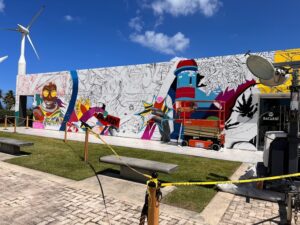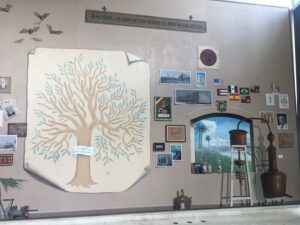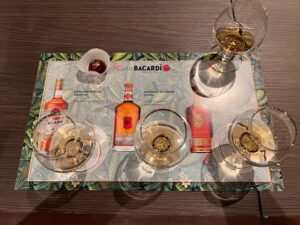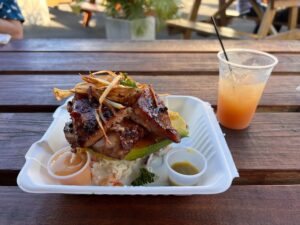
Always during any vacation, Amy, Aaron, and I suffer from premature grief that the vacation will eventually come to an end. We were feeling it this morning in particular even though we had three and half days of Puerto Rico ahead of us. I tried to remind myself that the vacation wasn’t over yet, we were still in Puerto Rico waking up to the dense foliage blanketing the beautiful mountains, and while it will be sad when we leave there was nothing to be sad about now in that particular moment.
Amy then told me about this German buddhist she used to listen to who put together a bunch of tapes that were all about being mindful of the moment. And he would calmly say things like, “Now is now,” and so forth. It was all very hippy-dippy, but even the Mayo clinic concludes that these meditative practices may reduce anxiety and depression. And if it seems to work for some people and it’s not doing harm to others, then what’s the matter with trying it out?
So, with mindfulness of the moment in hand, Amy and I had our usual swim in the pool, then later all three of us enjoyed mimosas on our little gazebo down the hill, and then we had a nourishing breakfast of fried egg sandwiches. And it was all just so lovely!
Ahead of us was another day in San Juan, that city that surprised us how much we enjoyed it. In fact, we enjoyed San Juan so much, we decided to skip El Yunque National Forest on día diez, so we could have a total of four-and-a-half days in this glorious, glorious city. While I’m a little sad we didn’t get to see a rainforest, I’m really happy that we got to have all that time in San Juan. I always feel more at home in cities anyway.

Our first stop in San Juan was to Casa Bacardí, the distilería for Bacardi rum. I must admit that rum always seemed like the bastard stepchild of all the distilled spirits, and Bacardi in particular was that one booze that frat boys drank to excess with Coke. However, our visit to the distilería totally changed my opinions of the spirit, as there is more to Bacardi rum (and rum in general) than that gross, clear, liquid monstrosity that mars shelves of liquor stores everywhere.
Before you visit Casa Bacardí, make sure you book a rum tasting tour ahead of time, which is what we did. You can also sign up for a mixology class or just visit the bar, but make sure to buy tickets ahead of time.
Before the tour started, we got to enjoy drinks that were included with our $75 tickets right outside in a large, open, covered pavilion. You can choose between a daiquiri, a mojito, or a specialty drink for the season. I think we got mojitos, but I honestly can’t remember. Whatever it was, it was refreshingly zesty in the comfortably warm Puerto Rican breeze. There also was a little food stand nearby where we enjoyed some sweet plantain empañadas.
Once the tour starts, you and your group board a trolley that takes you to a museum. The museum is one, giant, open room with a mural on one wall adorned with flags, images of previous owners, and a giant family tree. You’ll learn that Barcardí was founded in 1862 by Don Facundo Bacardí Massó and that the trademark bat logo was due to Facundo’s wife, Doña Amalia, who recognized that bats were a Taíno symbol of good health, family unity, and good fortune. You also get to have your first sip of Bacardí rum at the museum—and it wasn’t that hideously grotesque excuse for a distilled spirit, but rather a finely crafted, multi-layered, complexly created, carefully distilled libation fit for the most fancy and fussy deity.

Our trolley then took us to the tasting room where we got to admire four carefully poured glasses of rum, all shades of elegantly light hues of chestnut, hazel, and amber. We first went around the room introducing ourselves and where we were from, and our guide, Edwin, remarked that he once lived in Baltimore (where one of our group was from), but that he didn’t do very well in a winter climate, singing, “I am an island boy,” to great amusement.
Before we proceeded to drink the enticing rums, we first learned how to sniff the aroma (place your nose at 12:00 relative to the glass), how to describe what we smelled (butter, caramel, butterscotch, etc.), then how to sip (take one sip, let the sensations dissipate, then sip again to more fully appreciate the mosaic of flavors).
We worked our way through the four drinks (a four-year, eight-year, ten-year, and special reserve), while Edwin enthusiastically told us about how you can make ice cubes out of coconut water to add to a generous pour of rum or how you can fry bacon in a nice eight-year rum to dress up your breakfast a bit. My opinions of rum totally changed during this tasting, as rum—when crafted correctly—is just as alluringly exquisite as any well-crafted bourbon or Scotch or rye.
Soon our tasting was over, but before we left we enjoyed one more mixed drink on the pavilion (I think we had a rum old fashioned), taking in the delicately warm breezes of Puerto Rico once again.
Our next stop was the Miramar Food Truck Park, located outside of Old San Juan and in San Juan proper, right on Avenida de la Constitución in between Calles Ernesto Cerra and Monserrate. The park is open 12-10pm Wednesday to Sunday, so plan ahead so you don’t arrive at a closed park.

I neglected to take good notes on the food truck we decided to eat from, but it was a food truck that had really authentic Puerto Rico fare, stuffed avocados with shrimp and salmon. If there’s one food thing you must eat while you are here, it is a stuffed avocado from a food truck. As I remarked on día cinco when we dined at La Casita Blanca, the avocados here are so, so big and so, so tasty, and the way they stew their meats and seafoods to stuff the giant avocados yields a meal that is not only satisfyingly filling but also a celebration of the senses for your eyes and nose and mouth, una fiesta de las sabores exquisitos.
We next needed to make our way to Fajardo on the northeast coast to enjoy an excursion into a bioluminescent bay. Somehow we missed in our planning that the drive from San Juan to Fajardo was an hour, so we were a little bummed about how far away it was, but we carried on regardless. We had purchased tickets from Kayaking Puerto Rico to coincide with an evening with a new moon to limit how much light would interfere with our ability to see the tiny organisms light up the waters of the bay at night. However, they had called us ahead of time to tell us that the tiny dinoflagellates were lately being a little shy, and that we should lower our expectations about how ebullient they were going to be. In fact, they offered us a full refund. But we didn’t take them up on that offer, electing to carry on regardless.
Arriving in Fajardo at night, it would have been difficult to tell the difference between Fajardo and any boring old suburb of Minneapolis and Saint Paul like the lifelessly and monochromatically named cities of Blaine or Shoreview. (Isn’t Blaine the most suburby name of all suburbs to end the contest for the title of King of All Suburby Suburbs That Ever Did Burp, er, Burb?) Like Blaine and Shoreview, Fajardo itself didn’t have all that much to do, as we wanted to have a caffeinated pick me up, but there was no open coffee shop in sight.
Before long, however, we were all lining up to listen to the instructions from our kayaking master who had the most romantically charming accent that I couldn’t quite place: “Police be KARE-ffful off thee COO-rents off zee WAH-tors ass we maaaake our waaaaay to thee bye-oh-LOOM-een-eh-scent bay-ee.”
He explained that our route was a manageable few miles through a somewhat unmanageable río pequeño—but not too unmanageable—generously populated by salt-tolerant mangroves. It was really fascinating making our way through a narrow steam at night, flashlights of our guides casting shadows of jagged branches.
After a good half hour of kayaking, making sure to avoid the sharp branches and kayakers from other tour groups (“Wwwh-atch out fffor thee EN-emiesss!” our guide would sarcastically warn), we arrived at Laguna Grande, the one of three bio-bays of Puerto Rico (there are only five in the whole world). And, as we were warned, catching a glimpse of the little critters that light up the waters was somewhat a game of hide and seek. The only way we could see them was by covering our entire kayak in a tarp to block out the starlight and swirling our hands in the water in order to cause the dinoflagellates to light up instinctively, rather like willing tiny, sparkling, blue fireflies into existence in dark waters. While viewing the tiny creatures suffering from stage fright was still nonetheless informative, don’t go on a bioluminescent bay tour expecting to see sights like the images you can view here, whole areas of the bay alight with brilliant blue fairies.
We also got to take some time to view the night sky aglow in more stars than I ever recall seeing, our guide pointing out various constellations and other cosmic objects. All in all, I did enjoy our little kayaking adventure, but I love kayaking in general, so I was inclined to enjoy myself. That said, if you want your main highlight to be viewing mysteriously alight waters in the dark without much work on your part, you may want to take up your guide’s offer of a refund if they warn you that the bay has been less than glowing.
Soon, we found ourselves making our way back to shore and thenceforth all the way back to Jayuya. And we went to bed so excited because we still had two and half days to explore as many nooks and crannies of San Juan that we possibly could…
Spanish lesson for the day:
- The proper way to pronounce Bacardí is bah-cah-REE.
- The word for bay in Spanish is bahía. And a bioluminescent bay is bahía bioluminiscente.
- If you want to practice mindfulness in Spanish, you can chant to yourself, “Ahora es ahora,” or “Now is now.”
- And if you find a drive boring (no matter how much you chant, “Ahora es ahora,” to yourself), you can use the adjective aburrido. “Esta carretera es aburrida,” means, “This road is boring.” If the drive happens to be fun, however, you can say, “Esta carretera es divertida.” Likewise, if you find your kayaking master fun or funny, you can say, “Ese hombre es divertido,” or “That man is funny.”
Travel tips, day nine:
- As we were waiting to board the kayaks, there was some sort of tiny organism in the water that bit our legs, and I managed to brush them away, feeling a bit of matter accumulate in my hand as I hopefully squashed the whatever-it-was. So just watch out.
- Much of our driving today was on the more major highways (“carreteras”) that traced the shoreline and allowed for swifter traffic. So not all driving in Puerto Rico is an hour-long trek over 20 miles through hairpin turns and sharp switchbacks.
- I highly encourage you to spend at least three or four days in San Juan alone. It is an enchanting city with so much to do and see, and even four days doesn’t sound like enough.
*These photos by Amy Danielson. All other by me.
